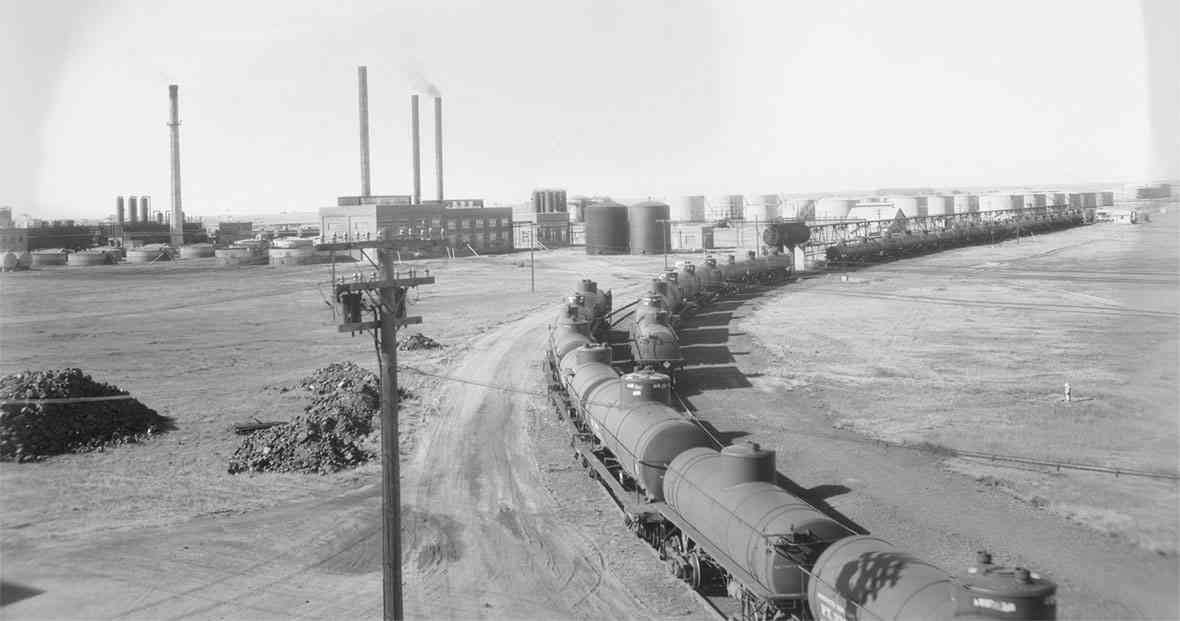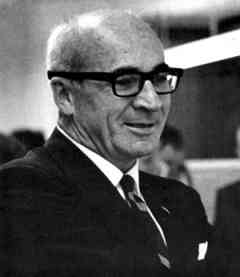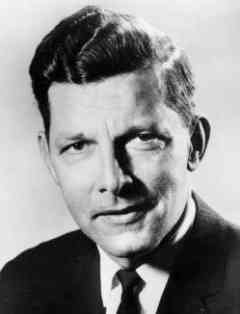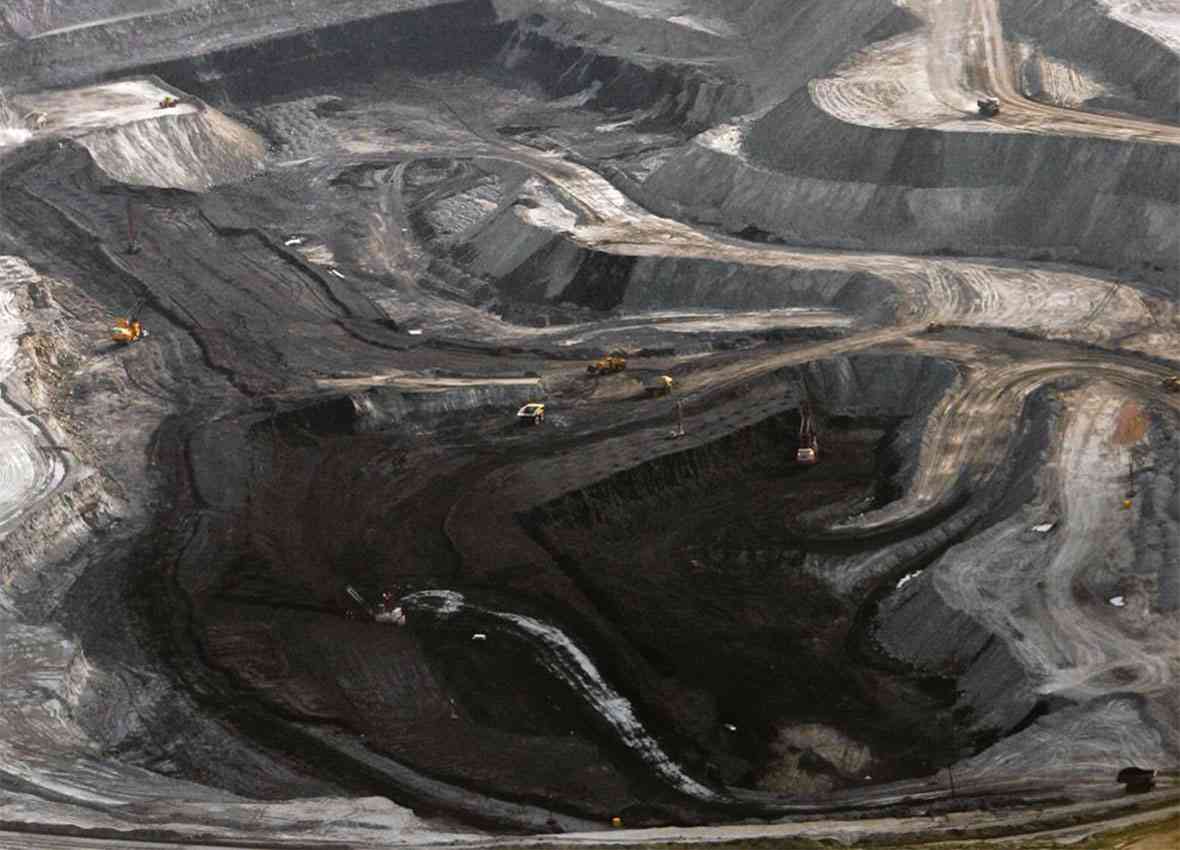- Home
- Encyclopedia
- Leasing Federal Minerals In Wyoming and The West
Leasing Federal Minerals in Wyoming and the West
On Oct. 21, 1976, Congress formally approved legislation that rewrote how the West was run: the Federal Land Policy and Management Act.
Democratic Sen. Henry M. “Scoop” Jackson of Washington, the ebullient chairman of the Committee on Energy and Natural Resources, called the law “a landmark achievement in the management of the public lands of the United States.”
The act quickly became better known by its acronym, FLPMA—pronounced “Flipma” by people who talked about it often. It achieved another milestone besides mere land management, one that wasn’t quite so grand or obvious.
Deep within the pages of the legislation, under the heading “Mineral Revenues,” the act spelled out an amendment to the Mineral Leasing Act of 1920, which up to that point had allowed 37.5 percent of the federal mineral royalties to be paid to the states. New language in the amendment mandated that, from that point on, a full half of all revenue generated on federal land mineral leases would return to the state of origin.
The amendment meant hundreds of millions of additional dollars for western energy producing states, Wyoming prominent among them.
Equally important, the passage of FLPMA, along with two other pieces of federal legislation—the Federal Coal Leasing Amendments Act of 1976 and the Surface Mine and Reclamation Act of 1977—gave testament to the enduring power of the Mineral Leasing Act, a law passed when Woodrow Wilson sat in the president’s chair.

None of these sweeping pieces of legislation altered the fundamental purpose of the Mineral Leasing Act: to oversee the leasing of hydrocarbons on federal-land—that is, oil, gas and coal but not gold, silver or uranium—while balancing conservation and promoting production.
The Mineral Leasing Act of 1920 was also the first piece of federal legislation to recognize—and compensate for—the impact of mineral development on local communities.
Rep. Roncalio’s initiative
The 1976 amendment was welcome news to the Rocky Mountain West, particularly to coal-rich New Mexico and Wyoming. The new financial fruits appeared in large measure due to the efforts of one individual in particular—Wyoming Rep. Teno Roncalio, a Democrat who had both political savvy and a deep understanding of the Mineral Leasing Act of 1920.

As the 1973 energy boom coursed through the West, Kathy Karpan, a former Roncalio staffer, remembers now that Wyoming’s Washington delegation saw an opportunity. While acknowledging that Wyoming senators Cliff Hansen, Republican, and Democrat Gale McGee played a critical role shepherding the royalty-boosting change through the Senate, it was Roncalio, she said, who orchestrated the amendment and set its passage in play.
“He was the spark plug on this initiative,” said Karpan, who had served as Roncalio’s press assistant in the 1960s. Karpan served as Wyoming’s secretary of state in the 1980s and ‘90s.
Roncalio wasn’t the first person to think about raising the federal mineral royalty rate. According to Karpan, raising the federal mineral royalty was an idea that had been around at least since the days of Jack Gage, who served as Wyoming governor from 1961 to 1963.
Roncalio, a scrappy, energetic son of immigrant parents, was from Rock Springs, Wyo., a town linked with coal mining since it was founded in the 1860s. Roncalio’s father was a miner.
“Rock Springs was also the poster child for how an energy boom could really mess up a town,” said Karpan.
“Teno had a seat on what was then called House Committee on Interior and Insular Affairs, now the Natural Resource Committee,” said Karpan. “For a long time he had been contemplating how to get more federal mineral money back to Wyoming. As a member of this committee, Roncalio became increasingly aware of the Mineral Leasing Act.”
 
|
To that end, said Karpan, Roncalio connected two dynamics: the resurgence of federally owned coal as an energy source and the opportunity that the Mineral Leasing Act of 1920 offered as a vehicle for Wyoming to capitalize on this revival.
Years in the making
The original Mineral Leasing Act of 1920, passed as Wyoming was sinking into a two-decade-long depression, had been something of a godsend for the state. Blessed with millions of acres of federal minerals, state officials had watched impotently as prospectors benefitted from the generosity of the Mining Act of 1872 and the Oil Placer Act of 1897. These two laws stated that all public lands containing petroleum or other minerals were "free and open to occupation, exploration, and purchase.”
A claimant simply had to dig a 6-by-6 foot hole, 10 feet deep, and prove he had found oil in commercial quality. A prospector who invested $100 per year for five years in improving the claim received ownership of the mineral rights and the surrounding 40 acres of surface land. Once they paid the federal government $2.50 per acre, claimants owned the land outright and had no further obligations other than local property tax.
After passage of the Mineral Leasing Act of 1920, however, companies or individuals could no longer patent a claim; that is, no longer could they look forward to eventually owning the land outright. Instead, they could lease the mineral rights from the federal government.
They could lease up to 2,560 acres per state on 20-year contracts. Leaseholders would then receive a percentage of the gross value of the minerals produced on the land, that is, a royalty, ranging from 5 to 12.5 percent. The state of origin got a 37.5 percent share of the royalty revenue. The federal government got the rest.
Wyoming immediately benefited from the new source of revenue. In 1921, Wyoming received $748,445 in federal royalties. That year, oil hit $3.07 per barrel, a price not seen since 1871.
Production and prices soon languished, however. Slack demand due to the Depression, combined with oversupply from such major discoveries as Oklahoma’s Seminole Field in 1923; the Oklahoma City Oil Field in1928; and East Texas oil fields in 1930 kept prices down. Crude oil averaged $1.19 per barrel in the 1930s.
Not only did major discoveries on private holdings chill exploration on federal lands, ideas about conservation made the Mineral Leasing Act into a political football. President Hoover, fretting about over production, ordered the Department of the Interior to nix all new leasing on federal land from 1929 to 1932.
Some thirty years later, a Senate committee investigating domestic oil resources recognized that the Mineral Leasing Act was created at time when “there appeared to be a serious danger of a speedy exhaustion of the domestic supply of oil and gas.”
The war shift
Yet, despite gloomy projections, America remained awash in oil. So flush with crude was the U.S. that World War II, with its huge demand for petroleum products, only modestly boosted output. The per-barrel price rose and dipped during the war but eventually fell from $1.27 in 1939 to $1.22 in 1945.
The tide was turning, however, and low prices didn’t reflect true demand, said Roger Stern, an assistant professor of energy at the University of Tulsa, in a recent interview. Price controls for oil were set in 1941 at depression-low 1930s levels. This, combined with pipeline shortages and a lack of credit, gave oil producers little incentive to deliver their product, despite high demand and ample reserves.
Secretary of the Interior Harold Ickes predicted that even if the U.S. had enough oil to win the war, peacetime demand would soon outstrip supply. Sure enough, according to Stern, “the U.S. became a net oil importer in the late 1940s.”
Washington proposed two avenues to alleviate the perceived problem: Encourage stable supply outside of the United States, which was later accomplished by courting Middle East oil producing nations, and at the same time increase domestic oil production from federal lands.
Sweetening the pot
During the war, Congress made attempts to amend the Mineral Leasing Act in favor of leaseholders, such as temporarily allowing for a flat royalty of 12.5 percent and permitting—in some cases—noncompetitive leases.
After the war, Congress continued to relax its conservation attitude. In 1946 and 1947, lawmakers passed a series of amendments to the Mineral Leasing Act, many of which are still in place today. They made permanent the royalty rate of 12.5 percent on noncompetitive leases. Lessees no longer were restricted to 2,560 acres per state, but now could lease 15,360 acres. Congress even allowed lessees the opportunity to exercise an exclusive nonrenewable two-year option to control 100,000 acres in addition to leasing 15,360 acres.
Congress also opened up more land for exploration. According to an article written in 1947 by David Miller, former assistant in charge of the Naval Petroleum Reserves in California, 150 million acres of federal land, which the government had acquired by condemnation or purchase, were, under the law of the time, not part of the public domain and therefore not subject to leasing.
The Mineral Leasing Act for Acquired Lands, passed in 1947, made those millions of acres (deactivated military bases, right-of-ways, abandoned homesteads, newly acquired Forest Service acreage) available for exploration and drilling, all governed under the Mineral Leasing Act of 1920.
Price roses. In 1948, the price per barrel crossed the $2.00/barrel mark, never to return.
But rising prices did little, if anything, to encourage more production. In 1953, Ross Malone, an oil and gas attorney from New Mexico and former U.S. deputy attorney general, estimated that only about 5 percent of the nation’s domestic oil production was from public lands administered under the Mineral Leasing Act of 1920.
In 1953, Congress also passed the Outer Continental Shelf Lands Act, a piece of legislation governing offshore oil and gas drilling on submerged lands under federal ownership. At first blush, the legislation had nothing to do with the Mineral Leasing Act of 1920. Yet as the years passed, offshore oil and gas production and, and the revenue from it, continued to rise when onshore output remained static. This tended to divert the attention of Congress away from onshore mineral leases.
The Mineral Leasing Act wasn't totally ignored. Congress created alternative opportunities for public-land energy exploration. In 1960, during another amending of the Mineral Leasing Act, Congress opened “native asphalt, solid and semisolid bitumen, and bituminous rock (both oil shale and tar sands)” for leasing under Mineral Leasing Act jurisdiction. Later Congress made accommodations for geothermal (geysers, hot water springs, and steam vents) energy.
The oil world took little notice. As a 1960 Senate report noted, “In the past several years there has been a potentially dangerous slackening exploration for development of domestic reserves of oil and gas so necessary for our security in war and peace.” According to the report, while U.S. domestic production had declined to 5.85 million barrels per day in May 1960, consumption rose to 9 million barrels per day.
The report explained the 1.3 million barrel decline in daily production resulted from global factors including the “fabulously flush production of Middle East oil fields” as well as increases in Venezuelan and North African production.
The rise of coal
The slide in oil production continued. From 1960 to 1968, the number of oil and gas leases governed under the Mineral Leasing Act dropped 40 percent, from 139,535 to 82,570. Leased acreage was almost cut in half. Yet anyone perusing the Bureau of Land Management bible of data, Public Land Statistics, could not help but notice the jump in coal leases. In the same time period that oil and gas leases were dwindling, the number of federal coal leases nearly doubled, from 294 to 541.
The rise got Washington’s attention. A federal study in 1970 pointed out that leased coal acreage on public lands in six western states—Colorado, New Mexico, North Dakota, Montana, Utah and Wyoming—had increased nearly tenfold in 25 years, from roughly 80,000 acres in 1945 to about 788,000 acres in 1970.
There was a little problem, however, and it spelled trouble for western coal states.
In its enthusiasm to encourage production, Congress had allowed for vast coal tracts, all operated under the Mineral Leasing Act of 1920, to be tied up by speculators waiting for higher prices before they commenced mining operations. According to the 1970 study, coal production on federal leases had dropped from 10 million tons in 1945 to 7.4 million tons in 1970. Of the total acreage under lease, more than 90 percent was not producing coal.
Thus, in 1971, officials in the U.S. Department of the Interior, convinced its minerals were benefiting mostly speculators, suspended coal leasing on federal land. Intended to last for only a short period of time, the suspension instead lasted eight years and effectively stopped federal-land coal sales for ten.
These conditions led to intense scrutiny of the Mineral Leasing Act of 1920 and its regulations concerning coal. Congress returned to its earlier conservation attitudes by passing the three pieces of legislation mentioned earlier: the Federal Coal Leasing Amendments Act of 1976, the Federal Land Planning Management Act (FLPMA) in 1976 and the Surface Mine and Reclamation Act of 1977.
Of these three, Roncalio and the Wyoming delegation chose FLPMA, which included a major overhaul of not just the mineral royalties rate but how the BLM administered leases, as the main vehicle to amend the Mineral Leasing Act of 1920.
At the time, coal leasing appears to have been under keen scrutiny from all sides. The FLMPA proposal, by contrast, while not without controversy, had the backing of at least some factions of the environmental movement, which gave it additional momentum. Roncalio and the other members of Wyoming’s delegation may have been acting quite shrewdly when they inserted the language amending the MLA of 1920 in the FLPMA bill, instead of into legislation more directly related to coal.
By doing so, they were directly helping their state. Wyoming, with its abundance of minerals, was sure to benefit from the royalty change. The state currently has 15.3 million federal acres under mineral lease, three times more than New Mexico, the state with the next highest number of acres.

Modern era
As the price of all carbon-based fuels soared in the late 1970s and early 1980s, the hunt for energy intensified on public land. Congress further tightened its oversight of the Mineral Leasing Act of 1920, particularly when it came to accounting. The major focus continued to be coal and, the relatively new kid on the block, natural gas.
As it approaches its centennial, The Mineral Leasing Act of 1920, now at 66 pages long more complex than it was, still upholds its original task: to strike the practice of outright land ownership—what legal scholars know as “absolute property”—from the process of claiming federal minerals, and to offset the impact of mineral production on local communities.
The concept of “absolute property,” which one legal writer defined as “that which is our own, without any qualification whatever,” was directly connected with pre-Civil War Supreme Court decisions upholding slavery and others, such as the Mining Law of 1872, upholding land and mineral acquisition. The MLA of 1920 was a radical departure from the absolute property concept, a Progressive Era affirmation that the concept of absolute property and conservation were ill-suited partners.
The act doesn’t appear a candidate for oblivion, either, as demonstrated by yet another request to shut down coal leasing on federal land. In September 2014, Sen. Ed Markey, Democrat from Massachusetts, found that the BLM underestimated the value of the coal reserves under the bureau’s management.
His core legal reasoning for demanding the suspension of leasing? The Federal Coal Leasing Amendment Act of 1976, which amended the Mineral Leasing Act of 1920 to require that all federal coal leases be offered competitively.
It underscores the intent of the original legislation: extracting minerals from the public domain is a regulated privilege, not a right, aimed at rewarding those who take the initiative but not at the expense of the owner: the American public.
Editor's Note: We extend special thanks to the University of Wyoming’s School of Energy Resources for support for this and other articles in an ongoing series on the history of Wyoming’s energy and extraction businesses.
Resources
Primary Sources
- Bennethum, Gary. Holdings and Development of Federal Leases. Washington, D.C.: United States Department of the Interior, Bureau of Land Management, 1970.
- Federal Coal Leasing Amendments Act of 1976, Aug. 4, 1976. Accessed Jan. 9, 2015, at http://digitalcollections.library.cmu.edu/awweb/awarchive?type=file&item=431612.
- Stern, Roger. Assistant professor of energy, University of Tulsa. Email with author, Jan. 8, 2015.
- The Supreme Court Reporter, vol. 35, St. Paul, Minn.: West Publishing, 1915, 310.
- U.S. Bureau of the Census. Statistical Abstract of the United States. Washington, D.C.: U.S. Government Printing Office, 1951, 697.
- U.S. Department of Interior, “Review of Planning Considerations in Federal Coal Leasing” (1984); 12, accessed January 11, 2015 at http://archive.org/stream/reviewofplanning2672unit/reviewofplanning2672unit_djvu.txt
- U.S. Energy Information Administration. “U.S. Field Production of Crude Oil.” Accessed Jan. 9, 2015, at http://www.eia.gov/dnav/pet/hist/LeafHandler.ashx?n=PET&s=MCRFPUS2&f=M.
- U.S. Government Accountability Office. “Coal Leasing: BLM Could Enhance Appraisal Process, More Explicitly Consider Coal Exports, and Provide More Public Information.” Report to Congressional Requesters, December, 2013. Accessed Feb. 16, 2015 at http://www.gao.gov/assets/670/660666.txt
- U.S. House of Representatives, “Mineral Leasing Act for Acquired Lands,” (2010): 1, accessed January 12, 2015, at http://legcounsel.house.gov/Comps/mlaacq.pdf
- U.S. Secretary of the Interior, “Federal Coal Leasing Report, 1977,” Annual Report of the Secretary of the Interior under Section 8 of the Federal Coal Leasing Amendments Act of 1975 (P.L. 94-377). Accessed Jan. 9, 2015, at http://archive.org/stream/federalcoalleasi12unit/federalcoalleasi12unit_djvu.txt.
- U.S. Supreme Court, Andrus v. Shell Oil Co., 446 U.S. 657 (1980). Andrus v. Shell Oil Co. No. 78-1815.Accessed January 10,, 2015 at https://bulk.resource.org/courts.gov/c/US/446/446.US.657.78-1815.html
Secondary Sources
- Congressional Budget Office, “Potential Budgetary Effects of Immediately Opening Most Federal Lands to Oil and Gas Leasing, (2012): 1, accessed January 13, 2015 at http://www.cbo.gov/sites/default/files/cbofiles/attachments/08-09-12_Oil-and-Gas_Leasing.pdf
- Flynn, Roger. “Daybreak on the Land: The Coming of Age of the Federal Land Policy and Management Act of 1976,” Vermont Law Review, Volume 29, (2012): 815, accessed January 11, 2015 at http://lawreview.vermontlaw.edu/files/2012/02/flynn.pdf
- Mansfield, Marla. “Through the Forest of the Onshore Oil and Gas Leasing Controversy Toward a Paradigm of NEPA Compliance,” 24 Land & Water L. Rev. 85 (1989): 86, Accessed January 14, 2015 at http://digitalcommons.law.utulsa.edu/cgi/viewcontent.cgi?article=1229&context=fac_pub
- Miller, David W. “Historical Development of the Oil and Gas Laws of the United States,” California Law Review, 51:3 (1963): 506, accessed January 8, 2015 at http://scholarship.law.berkeley.edu/cgi/viewcontent.cgi?article=3039&context=californialawreview
- Stern, Roger “Oil Scarcity in the UN National Security Policy, 1909-1980,” A Working Paper of the Oil, Energy & the Middle East Program, Princeton University (2012): 1, accessed January 9th at, http://www.princeton.edu/oeme/papers/Roger%20Stern%20Oil%20Scarcity%20Ideology%20in%20US%20National%20Security%20Policy.
- Sabin, Paul, Crude Politics: The California Oil Market, 1900-1940. Berkeley, Calif.: University of California Press, 2005, 119.
- Wicks, Gary J. “Coal Leasing Program: Department of Interior,” Tulsa Law Review, Volume 13, Issue 4 (1978): 644, accessed January 8, 2015 at http://digitalcommons.law.utulsa.edu/cgi/viewcontent.cgi?article=1426&context=tlr
Illustrations
- The 1928 photo of the Laramie refinery and tank cars is from the American Heritage Center. Used with permission and thanks.
- The photo of Teno Roncalio is by Frank Roncalio, the photo of Gale McGee is from Wikipedia and the photo of Cliff Hansen is from the Casper Star-Tribune. Used with thanks.
- The 2010 photo of a coal mine near Gillette, Wyo. is from nationalgeographic.com. Used with thanks.
